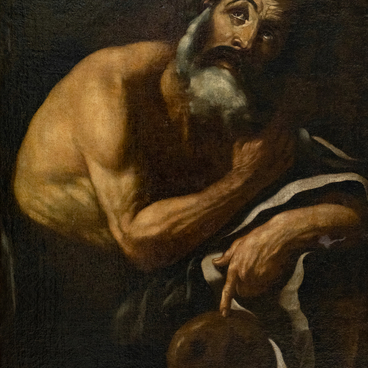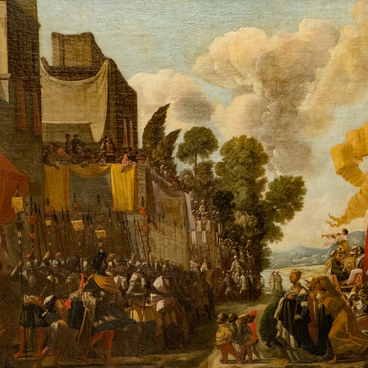The collection of the Sakha Republic National Art Museum contains a painting by an unknown Italian master “The Sacrifice of Abraham.”
The painting is narrative; the artist clearly and meticulously depicted the famous Old Testament story. The entire scene unfolds against the backdrop of a mountainous landscape. The scene is given in close-up. The viewer sees Abraham and the bound naked young Isaac: his head is turned, his face is not visible, and his hands are tied behind his back. A golden-haired angel is depicted on the left, stopping the hand of Abraham, who passes the test of obedience to God. The angel’s golden hair frames his head in soft waves, standing out against a dark background, his wings barely outlined behind his back.
Abraham is the main character of the painting; his figure is located in the center of the composition. The artist depicted the movement of the man in a half-turn when he suddenly hears a voice behind him. Abraham is portrayed not as an obedient, uncompromising executor of God’s will, but as a man in complete turmoil of feelings. He is agitated, which is manifested in his suffering, anguished look and distorted facial features.
Abraham turns Isaac’s head away with his hand, and in this gesture the artist expresses all the father’s feelings: the only thing Abraham can do for his son is to save him from the terrifying sight of the approaching blade.
Abraham’s purple cape, trailing from Isaac’s head to the hand with the knife, evokes an association with a stream of scarlet blood. The emotionality of the image is enhanced by the expression of light. The light accent runs diagonally across the painting, highlighting the faces of the angel, the elder, and Isaac’s shoulder. It also illuminates the hand of God’s messenger, which stops Abraham, the angel’s finger pointing to the lower left corner of the picture at the lamb, which should be sacrificed instead of Isaac. The meaning that the artist hides in the plot tells about Christ (the lamb in the thicket), who will be sacrificed for the sins of the human race.
The figures depicted extremely close to the viewer,
the close-up, the volume of the figures and the chiaroscuro drama — were all
borrowed by an unknown Italian artist from the painter who had a great influence
on the development of European painting of the 17th century, the great master
of the Baroque style Michelangelo Merisi da Caravaggio.


